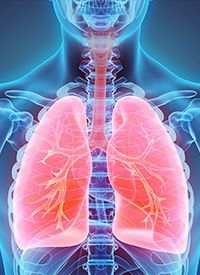Article
Lazertinib Outperforms Gefitinib in EGFR-Mutated NSCLC
Author(s):
The third-generation EGFR TKI lazertinib displayed a significant efficacy improvement compared with gefitinib in patients with EGFR-mutated advanced non–small cell lung cancer when given in the first-line.
Lazertinib Outperforms Gefitinib
in EGFR-Mutated NSCLC | Image
Credit: © yodiyim - stock.adobe.com

The third-generation EGFR TKI lazertinib (formerlyYH25448) displayed a significant efficacy improvement compared withgefitinib (Iressa) in patients with EGFR-mutated advanced non–small cell lung cancer (NSCLC) when given in the first-line, according to findings from the phase 3 LASER301 study (NCT04248829) published in the Journal of Clinical Oncology.1
At the July 29, 2022, data cutoff, findings from the study showed that patients who received lazertinib (n = 196) experienced a median progression-free survival (PFS) of 20.6 months (95% CI, 17.8-26.1) vs 9.7 months (95% CI, 9.2-11.3) among patients who were treated with gefitinib (n = 197; HR, 0.45; 95% CI, 0.34-0.58; P < .001). The overall response rates (ORR) were 76.0% (95% CI, 69.4%-81.8%) vs 76.1% (95% CI, 69.6%-81.9%), respectively (OR, 0.99; 95% CI, 0.62-1.59; P = .973), and responses were largely partial, with 2 and 1 patients, respectively, experiencing a complete response.1
Additional findings from the study showed that the PFS benefit conferred by lazertinib over gefitinib was consistent across all prespecified subgroups. The most pronounced benefit with lazertinib was observed among patients with a World Health Organization (WHO) performance status of 0 (HR, 0.34; 95% CI, 0.20-0.59), patients who were younger than 65 years (HR, 0.38; 95% CI, 0.26-0.56), and those who were not Asian (HR, 0.38; 95% CI, 0.23-0.64).1
The median duration of response (DOR) was 19.4 months (95% CI, 16.6-24.9) vs 8.3 months (95% CI, 6.9-10.9) in the investigational and control arms, respectively. The disease control rates (DCRs) were 93.9% (95% CI, 89.5%-96.8%) vs 93.9% (95% CI, 89.6%-96.8%), respectively (OR, 1.00; 95% CI, 0.43-2.30; P = .922).1
Further, overall survival (OS) data were immature at the data cutoff; however, the estimated 18-month OS rate was 80.3% (95% CI, 73.5%-85.5%) compared with 72.4% (95% CI, 65.2%-78.4%) for patients treated with lazertinib and gefitinib, respectively. The 24-month OS rates were 66.4% (95% CI, 56.5%-74.6%) and 58.4% (95% CI, 48.6%-67.0%), respectively.1
Patients in the lazertinib and gefitinib arms both underwent subsequent therapy (23.4% vs 54.3%) that included third-generation TKIs (2.0% vs 32.5%), cytotoxic chemotherapy (12.2% vs 11.7%), and non–third-generation TKIs (9.2% vs 9.6%).1
At the data cutoff, treatment was ongoing for most patients (55%) in the lazertinib arm. Reasons for discontinuation included disease progression (22%), adverse effect (AE; 10%), withdrawal by patient (6%), death (6%), and physician’s decision (1%).
In the gefitinib arm, 24% of patients were still on treatment at the data cutoff, and 24% crossed over to treatment with open-label lazertinib. Patients discontinued treatment because of disease progression (55%), AEs (9%), death (7%), physician’s decision (2%), withdrawal by patient (1%), loss to follow-up (1%), and other reasons (1%).1
Safety data from the study revealed the most patients in the lazertinib and gefitinib arms experienced a treatment-emergent AE (TEAE; 96% vs 95%). TEAEs related to study treatment (88% vs 85%), grade 3 or greater TEAEs related to study treatment (20% vs 21%), and serious TEAEs related to study treatment (both 5%) were reported in the 2 arms. One patient in the investigational arm experienced a TEAE related to study treatment which resulted in death.1
In the lazertinib arm, TEAEs resulted in treatment interruption (34%), dose reduction (21%), and treatment withdrawal (10%). Commonly occurring any-grade TEAEs included paresthesia (39%), rash (36%), pruritis (27%), paronychia (18%), and dry skin (15%).1
Patients who received gefitinib experienced treatment interruption, dose reduction, and treatment withdrawal at rates of 32%, 11%, and 9%, respectively. Common any-grade TEAEs consisted of diarrhea (39%), rash (37%), increased alanine aminotransferase (30%), and increased aspartate aminotransferase (26%).1
LASER301 was a global, double-blind study that randomly assigned adult patients with treatment-naïve, EGFR-mutated locally advanced or metastatic NSCLC who were eligible for frontline treatment with an EGFR TKI to receive either lazertinib or gefitinib. Additionally, patients needed to have at least 1 of the 2 common EGFR mutations associated with TKI sensitivity (ex19del and L858R) and could not have symptomatic as well as unstable brain metastases.
Lazertinib and gefitinib were given orally once daily at a dose of 240 mg and 250 mg, respectively. Patients in both arms received treatment until disease progression or withdrawal.1
The median ages in the lazertinib and gefitinib arms were 67 years (range, 31-87) vs 64 years (range, 25-86), respectively. Most patients in both arms were women (67% vs 60%), Asian (both 66%), had ex19del at randomization (both 62%), had a WHO performance status of 1 (75% vs 73%), and were never smokers (69% vs 76%). All patients included in the study had adenocarcinoma and nearly all patients in both arms had metastatic disease (both 97%).1
The primary end point was investigator-assessed PFS per RECIST 1.1 criteria. Secondary end points consisted of OS, ORR, DOR, DCR, and safety.1
Lazertinib is also under investigation in the ongoing phase 3 MARIPOSA trial (NCT04487080), which is examining the safety and efficacy of the agent combined with amivantamab (Rybrevant) with that of osimertinib (Tagrisso) in patients with locally advanced or metastatic NSCLC. The trial will enroll approximately 1074 patients and has a primary end point of PFS with secondary end points including OS, ORR, DOR, and AEs.2
References
- Cho BC, Ahn MJ, Kang JH, et al. Lazertinib versus gefitinib as first-line treatment in patients with EGFR-mutated advanced non-small cell lung cancer (NSCLC): results from LASER301. J Clin Oncol. Published online June 28, 2023. doi:10.1200/JCO.23.00515
- A study of amivantamab and lazertinib combination therapy versus osimertinib in locally advanced or metastatic non-small cell lung cancer (MARIPOSA). ClinicalTrials.gov. Updated June 29, 2023. Accessed July 11, 2023. https://classic.clinicaltrials.gov/ct2/show/NCT04487080








